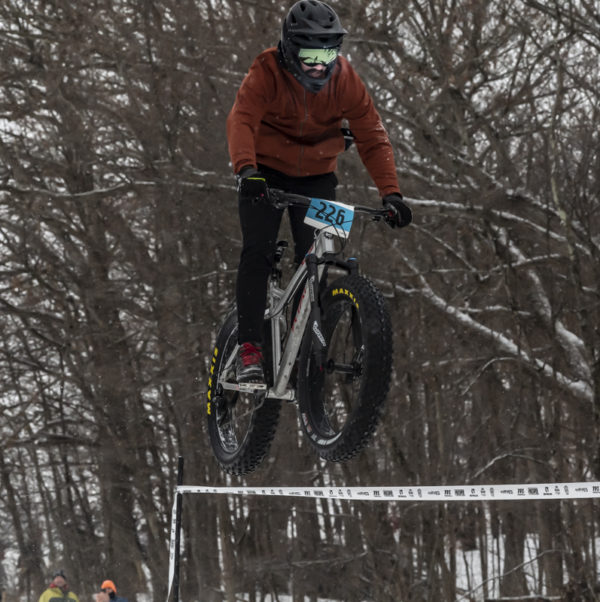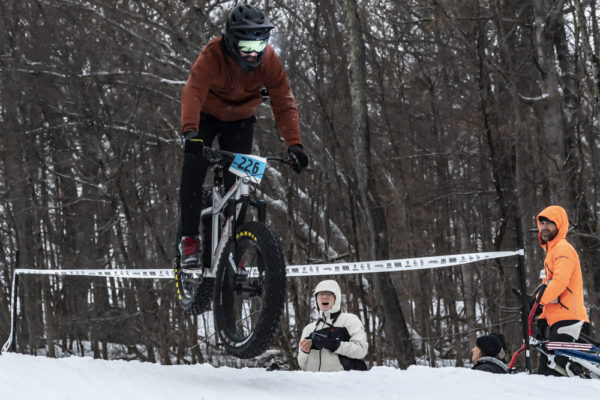Wyatt Maverick Full Review
I have had the privilege of riding the new Wyatt Maverick for the majority of the winter. This is the second iteration of their Maverick Fat-bike that is meant for all-around getting rowdy. I was able to ride the first generation of this fat-bike for a couple of races last year, but more on that later. The second generation includes much more of their “in-house” machining which makes for a pretty bad-ass looking bike IMO.
The Build
I chose to get this frame with just a clear coat, which I was very happy with. This frame is built out of 6061-T6 aluminum in Bangor, Wisconsin and features a whole lot of house-made parts. This frame stands out amongst the rest with some unique features that you don’t see much, especially considering it is made right here in the great dairy state. There is a seat tube gusset from the top tube that I initially didn’t like the look of, but grew on me. There are also machined chain-stay and seat-stay yokes that join to the seat tube. This increases the strength of the frame and gives me a lot of peace of mind as I have broken both steel and aluminum bikes at those joints in the past. These machined yokes are joined to rectangular tubing on the rear of the bike that joins to their own machined dropouts.
As you can see in the picture above, the seat tube is drilled for a stealth dropper post and there are fender/rack mounts.
The build that I got seems to be on the top end of what they offer on their website, with a mostly Shimano XT drivetrain, Race Face crank, and Shimano 4-piston brakes. The drivetrain performed as you would expect, with no issues to report. The shifting was smooth and the wide range cassette gave me plenty of gears for both churning through fresh snow or racing downhill. I have always preferred the more audible click of Sram shifters with my thick winter gloves, but have enjoyed the performance of this XT
The Shimano MT520 4 piston brakes had the great feel of all Shimano brakes with the added strength of larger brake pads and double the pistons. I especially appreciate this for both racing downhill and fooling around on one wheel.
This bike is built and designed around a 110mm travel Wren inverted fork. Even though there aren’t many inverted forks out there, I have experience to compare. I tested and reviewed an 11Nine inverted fork way back in 2013 and had a bunch of issues, including visible wear on the stanchions and oil leaks. This Wren had none of those problems, thus reinstating my hope in upside-down forks. In fact, I can say the Wren is the best suspension fork I have ridden on a fat-bike.
The cockpit was also from Wren with an aluminum stem and carbon handlebars. They were stiff and took some hard crashes in stride. One cool thing about Wyatt’s close relationship with Wren is that they offer a suspension-corrected fork that is the same as the inverted fork with 20% sag, keeping with the same great geometry.
The wheels were solid and smooth Sun-Ringle Mulefut 80’s setup tubeless with Maxxis FBR/FBF tires. These are by no means the lightest wheels and are probably some of the heaviest tires, but they are a bomb-proof combination that gives you all of the confidence you need. This bike is pretty heavy at about 37 pounds so just going with a lighter tire would probably be a big improvement in that category.
Rounding out the build was the PNW Cascade dropper post. I was very happy with this post even in really cold temps. My issue is having a frame that has routing for a stealth dropper, but only having an externally routed seatpost as an option from Wyatt. I loved this dropper post but would have liked the cleaner look of the stealth option.
The Ride
I was able to ride a Maverick last winter for a couple of races and loved the feel of that, so I was pleased when the updates for V2 didn’t include much if any, changes to the geometry. The Maverick continues to have their “modern trail geometry” that seems to be more and more common these days. I like to ride my fat-bike like a dirt jumper, cross-country bike, downhill bike, and fat-bike, so this geometry ticks all of the boxes.
I was able to race in a dual slalom race last year on the V1 Maverick. The Up To Snow Good dual slalom had almost a hundred participants and was at Tyrol Basin near Madison, WI. The Maverick was snappy at the start and a natural going downhill. I piloted that bike to an undefeated day, taking first place in the men’s category that included fat and “skinny” bikes of all types.
Disclaimer: No stormtroopers were harmed in the racing of this bike.
The other race I did on the first Maverick last year was an XC race at the reforestation camp in Suamico, which was composed of 100% groomed cross-country ski trail. There wasn’t much in terms of technical terrain there that tested the bike, but it did everything I asked of it and made for a fun day of chasing people that were faster than me.
(MAVERICK V1: Notice the difference in the seat/chainstays. V2 went to a much burlier configuration)
The biggest performance advantage I notice between the two mavericks is the stiffness and snappy feel you get with the newer bike. I just feel like more of my input is getting to the rear wheel with the V2’s stronger rear end.
One place where I really enjoyed the “trail geometry” was packing in fresh snow. As I’m sure you all know, riding in fresh snow can make staying upright very difficult. The trail makes getting going again even more difficult when more of your weight is over the handlebars. The Maverick puts you in a more upright position that gets your weight more centered on your bike and over your pedals.

One race I participated in on this bike was the downhill race at Alpine Valley ski hill in Wisconsin. They were expecting around 100 people at this race but over 300 turned out. This made for only a couple of runs down the hill and only one race run. There were also a couple of inches of snow falling throughout the day, which turns a packed ski hill into an absolute mess when bikes are involved. The Maverick was a blast going downhill and the geometry and build of this bike shined. The short chainstays and 67-degree head tube angle gave the bike a playful feel and stability going downhill. It was a blast taking this bike off some proper jumps.

Tomba-Images/ Tom Barnes AKA Tomba
The Verdict
This is a bike for someone who wants to do more than race on ski trails. The Wyatt Maverick allows you to ride anything from singletrack to downhill and everything in between. This bike isn’t the lightest nor is it the cheapest, starting out at $2199 with a carbon rigid fork and $999 for a frameset. If I had a choice between this or a similarly priced cookie-cutter carbon bike, I would take this in a heartbeat. The build quality of the Wyatt frame, all of the machined parts, and the do-it-all geometry would make this my bike of choice for my fat-bike needs.

The Wyatt Maverick earns 4.5 out of 5 gnomes.

Nice air! What a slick looking bike.
Any follow up on the Maverick, especially non-snow trail riding, jumping?
Been eyeing this one up hard! Glad I stumbled upon this review! My random ocd hates that the seat stay doesn’t line up with the top type but is just sooo close haha maybe that’s just me.